King station (Toronto)
King is a subway station on Line 1 Yonge–University of the Toronto subway system. The station is located at the intersection of King Street and Yonge Street in Toronto's Financial District.[2] Wi-Fi service is available at this station.[3]
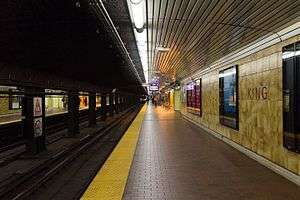 | |||||||||||
| Location | 3 King Street East, Toronto, Ontario Canada | ||||||||||
| Coordinates | 43°38′57″N 79°22′40″W | ||||||||||
| Owned by | Toronto Transit Commission | ||||||||||
| Platforms | Side platforms | ||||||||||
| Tracks | 2 | ||||||||||
| Connections |
| ||||||||||
| Construction | |||||||||||
| Structure type | Underground | ||||||||||
| Disabled access | No | ||||||||||
| History | |||||||||||
| Opened | March 30, 1954 | ||||||||||
| Traffic | |||||||||||
| Passengers (2018[1]) | 64,730 | ||||||||||
| Rank | 9 of 75 | ||||||||||
| Services | |||||||||||
| |||||||||||
History
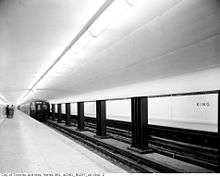
King station opened in 1954 as part of the first stretch of subway line built in Toronto, between Union and Eglinton stations.[4]
The original address for the station was 70 Yonge Street, which is still used in Toronto Transit Commission (TTC) maps, but the official website uses the address 3 King Street East, which both point to the intersection of the two streets, and the numbers are not used by nearby buildings.
A scissors crossover was installed just north of the station when the line was built, so that trains could easily crossover from one track to another, but was later removed in May 1984 during track rehabilitation because of maintenance costs. In 2012, the TTC decided to restore this crossover, as it would allow trains to turn back during service disruptions after the implementation of automatic train control,[5] which occurred on 2020-02-24.[6]
Station description
The station lies underneath Yonge Street at King Street, and is built on three levels. All five entrances are located on ground level, with three of them being sidewalk staircases from the northeast, southwest, and southeast corners of the Yonge Street and King Street intersection. The northwest corner entrance is through Scotia Plaza, and a semi-automatic entrance from Commerce Court East at 21 Melinda Street is staffed by a collector during rush hour. There is also an "exit only" sidewalk staircase from the southbound subway platform, just south of Melinda Street.[2] There are no elevators in this station, and it is not accessible for persons with physical disabilities.
Below ground level are two separate concourses, located under King Street (north concourse), and under Commerce Court (south concourse). All entrances and exits connect to the north concourse except for ones along Melinda Street. Below the concourses are the subway platforms, connected by stairs and one escalator to the northbound platform on weekdays from 3:00 pm to 6:30 pm.[7]
Gateway Newsstands located in the north concourse is the only tenant in the station.
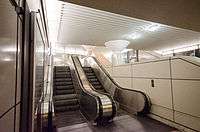
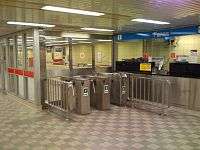
Station improvements
As part of its Public Art Program announced in June 2017, the TTC intends to install an artwork titled Light Canopy by artist Sean Martindale. The work is an animated lighting system to be set into the ceiling above the stairwell at King station's western entrance, and will give passers-by the feeling of passing under tree foliage.[8]
Subway infrastructure in the vicinity
North of the station, the subway travels through a scissors crossover through its tunnels underneath Yonge Street, past Queen Street, and into Queen station. South of the station, the subway continues underneath Yonge Street, until it reaches Front Street, where it turns 90 degrees west and passes through a crossover into Union station.
Nearby destinations
The destination for many people using King station is the financial district and its numerous office towers, connected to the station by the underground PATH system of pedestrian tunnels. These include the Canadian Pacific Building, Scotia Plaza, Commerce Court, Toronto-Dominion Centre and First Canadian Place.
This is also the closest station to One Yonge Street, the King Edward Hotel, St. James Cathedral, Toronto Sculpture Garden, St. Lawrence Hall and the St. Lawrence Market.
Surface connections
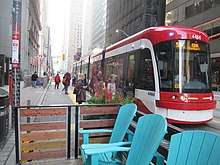
A transfer is required to connect between the subway system and these surface routes:
TTC routes serving the station include:
| Route | Name | Additional Information |
|---|---|---|
| 97B | Yonge | Northbound to York Mills station and southbound to Queens Quay |
| 141 | Downtown / Mt. Pleasant Express | Rush-hour service only; extra fare required |
| 142 | Downtown / Avenue Road Express | Rush-hour service only; extra fare required |
| 143 | Downtown / Beach Express | Rush-hour service only; extra fare required |
| 144 | Downtown / Don Valley Express | Rush-hour service only; extra fare required |
| 145 | Downtown / Humber Bay Express | Rush-hour service only; extra fare required |
| 304 | King | Streetcar; Blue Night service; eastbound to Broadview station and westbound to Dundas West station |
| 320 | Yonge | Blue Night service; northbound to Steeles Avenue and southbound to Queens Quay |
| 503 | Kingston Road | Streetcar; weekday daytime service (upgraded from rush-hour only service on a trial basis);[9] eastbound to Victoria Park Avenue from York Street |
| 504A | King | Streetcar; westbound to Dundas West station and eastbound to Distillery Loop |
| 504B | Streetcar; eastbound to Broadview station and westbound to Dufferin Gate Loop | |
| 508 | Lake Shore | Streetcar; rush-hour service only; eastbound to Parliament Street and westbound to Long Branch Loop |
References
- "Subway ridership, 2018" (PDF). Toronto Transit Commission. Retrieved February 5, 2019.
This table shows the typical number of customer-trips made on each subway on an average weekday and the typical number of customers travelling to and from each station platform on an average weekday.
- "TTC King Station". Toronto Transit Commission. Retrieved August 21, 2014.
- "Wi-fi Now Available At". TCONNECT. Archived from the original on December 4, 2014. Retrieved January 8, 2015.
Each of the 65 underground stations will have wireless and Wi-Fi service by 2017
- "A Cavalcade of Progress, 1921–1954". Toronto Transit Commission. 1954. Retrieved May 23, 2013.
- Bow, James. "A History of the Original Yonge Subway". Transit Toronto. Retrieved August 21, 2014.
- "TTC's new signaling system extended to Queen Station". Toronto Transit Commission. February 24, 2020. Archived from the original on February 25, 2020. Retrieved February 25, 2020.
As part of the work, a train turn-back was added to King Station, providing more operational flexibility during operational issues on Line 1.
- "TTC King Station – Elevators and Escalators". Toronto Transit Commission. Retrieved August 21, 2014.
- "TTC Public Art Program". Toronto Transit Commission. June 5, 2017. Retrieved July 18, 2017.
- "Editorial – November Board Period Service Changes". The Coupler. Toronto Transit Commission. October 27, 2019. Archived from the original on November 15, 2019. Retrieved November 15, 2019.
External links
![]()